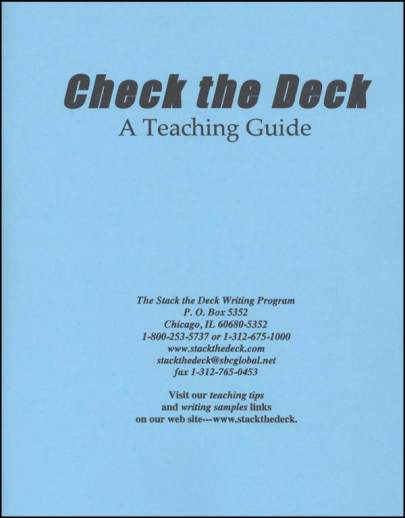We use cookies to make your experience better. To comply with the new e-Privacy directive, we need to ask for your consent to set the cookies. Learn more.
Check the Deck Teacher Guide
If you spend any time playing cards, you may already be familiar with the meaning of the term "stack the deck." To "stack the deck" is to arrange the deck of cards in your favor prior to the beginning of play - making it much easier to win the game. Translate that into a series of composition textbooks, and you can see the advantage of having someone "stack the deck" of English writing and composition skills in the student's favor. Accomplished through an engaging and encouraging text, which is also structured and well-organized as it flows from the easy to the complex, this series has been called "unpretentious," "organized," "systematic," and "fun" by teachers who have used it. Each level has both a teacher and a student book. Student books are written to the student, who can either work through them independently or with other children or the teacher. The text is conversational and interspersed with plenty of exercises, activities, and assignments. The books have space enough to be considered consumable, or students could use a separate notebook to record answers/writings if more than one student will use the program. Teacher guides give background information on the teaching process and skills focused on in the corresponding student book, as well as practical, research-based strategies for teaching the student text. Some of the labor and time saving tools utilized in the course include: scoring rubrics (which will help students know what is expected of them), think sheets (to help in the brainstorming phase), SOS sheets (a communication device that helps teachers point out weaknesses and offer helpful suggestions), and checklist sheets (so students can make sure they have fulfilled what was expected). This series is truly worth considering as you investigate the writing programs available to the homeschool market. The following gives more detail of specific coverage. ~ Zach
Grades 3-4. Eight units look more in depth at descriptive writing, imaginative problem solving, reporting, persuading, narrating, explaining, literature based writing, and researching. Each unit ends with a major writing assignment, and has four components that lead students up to that point: oral language into writing, simple sentence combining, composition rules, and writing with style. The book walks students through the writing assignments using the four-stage writing process of prewriting, writing the first draft, rewriting, publishing.
| Product Format: | Softcover Book |
|---|---|
| Brand: | Stack the Deck Writing Program |
| Grade: | 3 |
| Length in Inches: | 8.5 |
| Width in Inches: | 7 |
| Height in Inches: | 0.25 |
| Weight in Pounds: | 0.25 |

